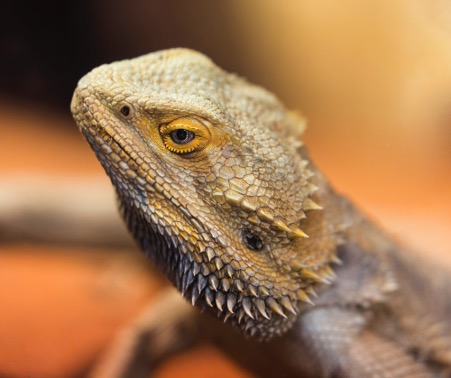
Bearded Dragon Care Sheet
Scientific Name: Pogona vitticeps
Country of Origin: Australia
Expected Lifespan: 15 Years Plus
Size: 45-60cm
Bearded dragons (Pogona vitticeps), or 'beardies', are one of the most popular lizards in captivity in the UK. The species originates from dry scrublands and woodlands in Australia, and the environment of captive lizards should reflect their natural habitat as much as possible. Their lifespan is usually 10 to 15 years or more, so they're quite a commitment.
Housing
Bearded dragons should be kept in a vivarium. Good ventilation is essential to reduce the risk of respiratory infections, and it should be made from solid material that is easy to clean and holds heat well. The minimum size for 1 adult bearded dragon is 120cm long, 60cm high and 60cm deep, but providing a larger space can only benefit and improve the quality of life for your dragon. The vivarium must be secure to prevent escape and free from hazards that might cause injuries.
Temperature/Light
To keep your beardy healthy, you need to create a thermogradient in the vivarium: a hotter (38–42°C) bright end, heated with a 60–100 watt light bulb, to a cooler (22–26°C) shaded end. Place a natural stone in the hot end – the ‘basking zone’ – to provide access to the heat, though your beardie’s back should not get closer than 25–30cm from the lamp. The bulb needs to be fitted with a wire mesh guard, to make sure it can't burn the beardie. Make sure you use a thermostat to regulate the temperature but use an infrared thermometer to record the temperatures at both ends daily as well. The temperature should not drop below 20–22°C at night, so you may need to use a ceramic heater (non-light-emitting) to maintain the air temperature. It’s important to provide opportunities for natural behaviour in captivity, called ‘enrichment’. Provide stones and branches for climbing, and a hide at both ends of the vivarium so the bearded dragon can feel secure. In the cool end, a box such as a plastic tub with an entrance cut in the top and filled with a sand/soil mixture provides opportunities for digging
Reptile Accessories:
Cleaning
It’s important to keep your vivarium clean. Otherwise, it can pose a health risk to your pet and to you: reptiles can carry salmonella, so wash your hands before and after cleaning or handling to reduce the risk of infection.Diet
A large sized water bowl should be placed in the dragon's enclosure. You might never see the dragon drink from it but it should be there as a back-up. You might notice the dragon use it for bathing, this is usually to cool down or to help loosen its shedding skin. Both the food dish and water bowl should be kept on the cool side of the enclosure to prevent them from raising the humidity in the enclosure. You can also give your beardie a Jelly pot for mositure.
Reptile Food & Accessories:
Bearded dragons are ‘omnivorous’, meaning they eat both live invertebrates (called ‘livefood’) and plants and vegetables (called ‘greens’).
Feed a variety of livefoods such as crickets (brown house crickets, silent crickets or black crickets), locusts and ‘calciworms’, no bigger than the size of the dragon’s mouth. Remove uneaten livefood from the vivarium as some insects can bite your dragon. As your beardie grows add dubia cockroaches, mealworms and morios to their diet and give waxworms as a treat.
Handling
Bearded dragons like to be handledDo not remove your bearded dragon from the vivarium for so long that its core temperature drops. Around 10 to 15 minutes at a time is a safe period for this, depending on the air temperature. Keep other pets separate, regardless of how trustworthy they have been before. If contained safely, such as in a secure pen, the bearded dragon can be taken outdoors on bright summer days for some natural UV and enrichment. In this case, ensure that your beardie also has access to shade and supervise them constantly.
Shedding
Bearded dragons shed their skin in large pieces. There is no rule as to how often this will happen but young bearded dragons will shed skin more frequently. When ready to shed, the dragon may look dull as the old skin becomes dry, then the skin should come off easily over a day or so. Don’t pull off old skin if it seems stuck as it can tear the new skin underneath. If patches still remain after a shed, try bathing the dragon in shallow, tepid water for about five minutes to soften it. Poor shedding on the feet can cut off the blood supply and lead to the loss of toes. However, if your dragon is well hydrated this should not be an issue. Most shedding issues can be corrected by adjusting hydration and humidity. As long as it doesn’t create high humidity throughout the vivarium, lightly spray the digging box to provide an area of humidity.Brumation
During cooler seasons, it's normal for bearded dragons to slow down, sleep more and eat less. It's a bit like hibernation, but for lizards, it's called brumation. They shouldn't lose weight or stop eating entirely, so keep a close eye on them and get in touch with your vet if they're losing weight.












